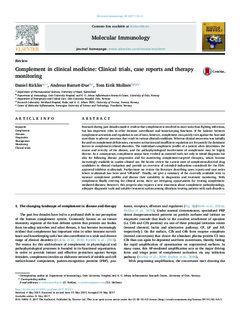| dc.contributor.author | Ricklin, Daniel | |
| dc.contributor.author | Barratt-Due, Andreas | |
| dc.contributor.author | Mollnes, Tom Eirik | |
| dc.date.accessioned | 2018-02-07T15:02:07Z | |
| dc.date.available | 2018-02-07T15:02:07Z | |
| dc.date.created | 2017-11-13T13:34:26Z | |
| dc.date.issued | 2017 | |
| dc.identifier.citation | Molecular Immunology. 2017, 89, 10-21. | nb_NO |
| dc.identifier.issn | 0161-5890 | |
| dc.identifier.uri | http://hdl.handle.net/11250/2483372 | |
| dc.description.abstract | Research during past decades made it evident that complement is involved in more tasks than fighting infections, but has important roles in other immune surveillance and housekeeping functions. If the balance between complement activation and regulation is out of tune, however, complement can quickly turn against the host and contribute to adverse processes that result in various clinical conditions. Whereas clinical awareness was initially focused on complement deficiencies, excessive activation and insufficient regulation are frequently the dominant factors in complement-related disorders. The individual complement profile of a patient often determines the course and severity of the disease, and the pathophysiological involvement of complement may be highly diverse. As a consequence, complement assays have evolved as essential tools not only in initial diagnosis but also for following disease progression and for monitoring complement-targeted therapies, which become increasingly available in routine clinical use. We herein review the current state of complement-directed drug candidates in clinical evaluation and provide an overview of extended indications considered for the FDA-approved inhibitor eculizumab. Furthermore we review the literature describing cases reports and case series where eculizumab has been used “off-label”. Finally, we give a summary of the currently available tests to measure complement profiles and discuss their suitability in diagnostics and treatment monitoring. With complement finally entering the clinical arena, there are intriguing opportunities for treating complement-mediated diseases. However, this progress also requires a new awareness about complement pathophysiology, adequate diagnostic tools and suitable treatment options among clinicians treating patients with such disorders. | nb_NO |
| dc.language.iso | eng | nb_NO |
| dc.publisher | Elsevier | nb_NO |
| dc.rights | Attribution-NonCommercial-NoDerivatives 4.0 Internasjonal | * |
| dc.rights.uri | http://creativecommons.org/licenses/by-nc-nd/4.0/deed.no | * |
| dc.title | Complement in clinical medicine: Clinical trials, case reports and therapy monitoring | nb_NO |
| dc.type | Journal article | nb_NO |
| dc.type | Peer reviewed | nb_NO |
| dc.description.version | publishedVersion | nb_NO |
| dc.source.pagenumber | 10-21 | nb_NO |
| dc.source.volume | 89 | nb_NO |
| dc.source.journal | Molecular Immunology | nb_NO |
| dc.identifier.doi | 10.1016/j.molimm.2017.05.013 | |
| dc.identifier.cristin | 1513501 | |
| dc.description.localcode | © 2017 The Author(s). Published by Elsevier Ltd. This is an open access article under the CC BY-NC-ND license (http://creativecommons.org/licenses/BY-NC-ND/4.0/). | nb_NO |
| cristin.unitcode | 194,65,15,0 | |
| cristin.unitname | Institutt for klinisk og molekylær medisin | |
| cristin.ispublished | true | |
| cristin.fulltext | original | |
| cristin.qualitycode | 1 | |

